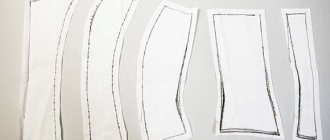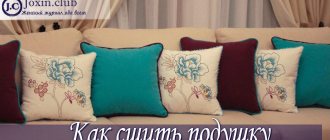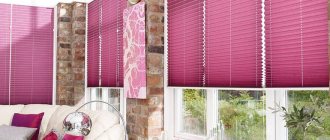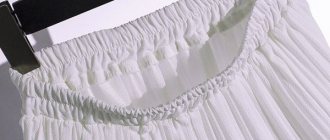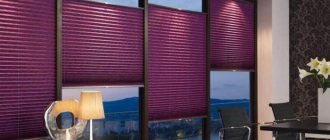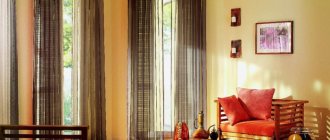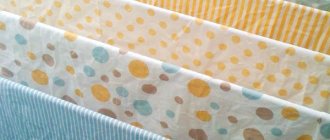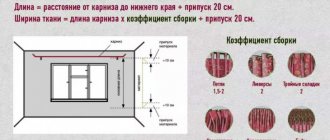Pleating on a template
First you need to make a template, which can then be used repeatedly to pleat the fabric. To do this you will need:
- drawing paper - the size and number of sheets depend on the type of parts;
- fabric with adhesive base;
- long ruler or metal construction meter;
- scissors, pencil, stationery clips;
- iron with steam generation function;
- any heavy load.
Making a template and performing pleating is carried out in the following sequence:
- Draw whatman paper in accordance with the planned width of the folds. It is important to maintain precise markings so that the pleating is smooth and uniform.
- Fold the sheet like an accordion along the marked lines, laying the folds in one direction.
- As folds form, iron them with steam and secure the edges with paper clips.
- Prepare a fabric with an adhesive base (you can take any material and coat it with silicone glue) the same size as the folded paper “accordion”. Glue the fabric to one side of the Whatman paper blank. Iron the template thoroughly and dry it.
- Now you can do it on pleated fabric. Place the material for the skirt or decorative detail into the resulting template and ensure that the folds are even.
- Cover the template with the workpiece with a linen cloth and gently iron it with plenty of steam several times, avoiding movement.
- Place heavy objects on the template and leave to stand for 8-10 hours.
- After the time has passed, remove the pleated.
Natural fabrics should be ironed through a cloth soaked in a fixing solution (stir 20 grams of soap shavings and 2 tablespoons of vinegar in 3 liters of water).
Manufacturing technology of corrugated and pleated
The fabric in small unstitched folds owes its appearance to Egyptian fashionistas. The costume of ancient Egyptian women (“kalaziris”) consisted of a straight shirt with one or two straps, revealing one breast. Noble ladies decorated kalaziris with embroidery or pleating. It is known that the Egyptian men's suit for special occasions, shenti, was also decorated with ironed folds.
Years passed: pleated fashion moved from women's fashion to men's fashion, and then came back. At different times, pleated skirts and capes adorned representatives of noble families and adherents of various religions. Men's casual clothing made from pleated fabric appeared during the Renaissance.
Later, folds became the main distinguishing feature of Scottish kilts. Unlike classic tartans, kilts that appeared in manufactories in the 18th century were decorated with ironed pleats. Over two centuries, the cut and width of the folds have changed more than once.
Suits with pleated elements are also found among eastern peoples. In particular, Azerbaijani outerwear arkhalyg has a mandatory pleated trim on the hem.
Until the 20th century, classic formal Chinese full-skirts were also decorated with pleated folds on the side surfaces framing the smooth parts of the panels with embroidery.
Folds have become especially popular in the Japanese uniform - seifuku. Thanks to high school anime cartoons, the sailor style with a pleated skirt is now used all over the world.
Today, “pleated” is not only clothing, but also interior elements - curtains, blinds, tablecloths, etc.
Non-professionals often confuse pleated fabric with corrugated fabric. Let's figure out which cut can be safely called pleated, and what is its difference from corrugation.
Despite the fact that pleating appeared as a separate type of fabric processing long before the beginning of our era, the name for small parallel folds on fabric was invented only in the 17th century in France (from pli - fold). The width of the segments ranges from 0.5 to 5 centimeters. The folds are either bow or counter pleats. Natural pleated fabric - silk, chiffon, taffeta can only be dry cleaned; the synthetic counterpart can be washed by hand.
Corrugation (or corrugated fabric ) is a series of long-term parallel folds or small folds tapering towards the center. Unlike pleated, a corrugated “accordion” consists of folds with sides of the same width (for example, 1 cm - hem, 1 cm - fold), but can also be flared. The cleaning conditions for this type of fabric are similar to pleated fabric. It is important to note that during washing, the folds on natural fabrics will not come apart, but will lose their appearance and will look untidy. The strength of fixation of folds directly depends on the composition of the fabric.
At home, making corrugated and pleated fabric is a long and complex process. In the atelier, the craftsmen will cope with this painstaking work faster: the craftswomen have special equipment (autoclave) at hand, which ensures a high speed of production of the material and the absence of defects.
If you decide to experiment with pleating yourself, use our tips:
- To make textured fabric (crumpled fabric also belongs to this type), you will need special forms with a pattern, which will subsequently be imprinted on the material. Among the most popular forms are “flared”, “half-bellied”, fantasy (curly corrugation). The blanks are steamed in a tank of water (a home bath can also be used). Using molded sheets, several pleated fabrics with different patterns are simultaneously produced.
- Form sheets can be bought at a studio, from private craftsmen, or made yourself. Thick drawing paper is ideal for this. It is durable and has a thin fold line, eliminating creases in the fabric. To corrugate one piece of fabric, two forms are needed (up to 12 sheets of whatman paper - 240 folds) - upper and lower, with the same pattern. On average, the productivity of one paper uniform is 50 skirts.
- It is more difficult to pleat the finished product than linen: if you are using this technology for the first time, start with a small test piece of fabric.
- Corrugation should be done in a room that can be quickly ventilated, since the smell released during steaming is not very pleasant. To make the folds “grab” more reliably, the workpiece can be soaked in vinegar (1 part 70% essence, 3 parts settled water).
- After steaming, the fabric must be dried in a drying cabinet or in the fresh air. You can use an industrial hair dryer. At this stage, the corrugation can be considered ready, and the pleated must be laid out on a flat work surface with an ironing cloth and the folds carefully laid out.
- If you don’t have any molds or a tank at hand, you can use a regular iron with a steam function and lay out the folds by hand. It is better to mark the future “accordion” on the fabric with chalk rather than soap - the latter dissolves when steamed. Recognized masters will consider this method bad manners, but for one-time pleating this will be enough. Remember that you will need three times more fabric for pleating compared to the width of the finished product.
How to restore pleating?
It is necessary to take care of pleated items with special care. Improper ironing or washing may damage the folds.
Before washing, you need to thread the pleated fabric along the hem and in the middle with non-fading threads so that the folds do not become deformed. Place the product in a washing bag and use only delicate cycles.
You can almost always return your favorite clothes to their original appearance, even if the folds are severely damaged. Algorithm for restoring pleating:
- Baste the broken folds along the entire length or fasten them with pins. Starch and leave to dry.
- Meanwhile, prepare the fixing composition. You will need 1 tbsp. l. sugar and gelatin, 100 ml of thick soap solution, 70 ml of table vinegar. Soak gelatin in cold water for 40-50 minutes. After swelling, add sugar to it and stir until dissolved. Then dilute the mixture with soapy water and add vinegar.
- Remove the pins - the folds on the skirt should be held in place by starch.
- Place the product on a sheet of tracing paper and cover with a cotton cloth soaked in a fixing compound. Place another sheet of tracing paper on top so that the impregnation does not stick to the surface of the iron.
- Iron until completely dry. Now the folds will be fixed.
Pleating looks original and elegant on children's and adult items. The technology for creating folds in fabric will help lovers of needlework to significantly expand their creative capabilities.
This is a quote from Lönn's post. Original post from PLISSE master class.
1) We measure the volume of the hips, since to make a pleated skirt, you need a fabric equal in width to 3 girths along the hip line. For example: hip circumference is 70 cm, then we need a canvas width of 70x3 = 210 (cm). The length of the canvas is equal to the length of your product.
2) We cut our future skirt. When sewing 2 or more parts, it is better to sew the seam open-iron so that there is no excess thickness when folding. We overlock all open cuts. I also overcast the top edge so that the fabric does not fray during the process.
We hem the bottom not reaching 5-7 cm to the edge on each side, for ease of sewing the side seam.
PLEASE NOTE THAT WHEN STITCHING THE SPACE BETWEEN THE FOLDS ON THE FRONT SIDE IS NOT VIOLATED.
We put two sheets together, fasten them and mark them with a needle (the pencil will leave lines on the light fabric), piercing both sheets. This is done to ensure that both the upper and lower parts of the form are marked exactly the same.
We draw lines either with a thick needle with a blunt end, or with a blunt screwdriver without cutting the paper (a screwdriver is preferable, it is more convenient to hold and regulate the pressure on the paper). When making the sample, I used an old manicure set.
Making straight pleated at home
To create a pleated fabric, we will need drawing paper, the number of sheets and their size depend on whether you will be making a skirt or any detail for finishing, fabric, iron construction meter, large paper clips, Moment Crystal glue, a needle, knife, pencil, scissors, cotton or linen fabric for ironing if using an iron, thread, sewing machine and overlocker, iron (I use it with a steam generator), some heavier weight for the press (books, the same sewing machine will do).
I'll tell you more about the tools. Whatman paper can be in sheets of different formats A1, A0 and rolled Whatman paper 1.20mx10m, I use exactly this for my forms, because... It suits me better, it can be used to make shapes for any length of skirts. A metal construction meter is needed to accurately mark the folds, because... deviations are not allowed, otherwise the shape will not form and will be thrown away; wooden or plastic rulers will not work.
Glue will be needed to glue sheets of whatman paper.
The knife should either be an old dull one, or use its other side. Using a steam generator, steaming pleated pleats will be much faster than using a regular iron, because... there the steam comes out under very high pressure. A household iron will take longer and it is advisable to weigh it down with something, or you will have to put a lot of pressure on it. It is better to take fabric with synthetic content of at least 50%; if you are planning to make pleated fabrics from natural fabrics, then only dry clean them. I do not use any special impregnation compounds in this manufacturing method. Fabrics can be different in texture, then in density: chiffon, tulle, synthetic silk, stretch satin, thin knitwear, thin suiting and dress fabrics with good drape, gabardine, eco-leather. I will use chiffon in MK.
First, let's cut out whatman paper, for the shape you will need to make 2 identical sheets, the short side is the length of your skirt or finishing part + 3 cm in reserve, more is possible, long = (hip circumference + 5 cm) x3 for skirts, for finishing - length cut (for example yoke line) x3. On one of the sheets, draw lines along the two long sides 1.5 cm from the edges.
We mark future folds, mark from the edge with dots on the line from the edge 1 and 2 cm, then make notches every 2 cm, as in the photo. Mark with a sharp pencil as accurately as possible.
We combine the two sheets together and press them down with weights so that they do not move in any way. Use a needle to punch all the points on both sides of the form.
Use the blunt end of a knife to press the fold lines along the punched points on both sheets of the form.
We bend the shape along the pressed lines. Glue the sheets together with glue; the glued seam of the upper and lower parts of the form should match.
We put the upper part of the form into the lower one, all the folds should come together and the form should be folded. I specially moved the top part a little so that it could be seen.
Next, we begin to steam the mold with folds in place so that it becomes elastic and does not tear later. I do this with a steam generator, if you have an iron, then first moisten the cotton iron in water, wring it out, apply 3-4 layers to the mold and set the folds with the iron at maximum temperature without steam.
Let the form dry, you can put it on the radiator or next to it to dry faster. Then we straighten all the folds with an iron or a steam generator on both parts of the form so that the fabric then lies flat.
Now you need to prepare the fabric. If the composition contains cotton, viscose, wool, silk, then rinse and dry it first so that the fabric does not shrink later, iron it, cut the panels according to your size - total width of the fabric = (Ob + 5 cm) x 3, length = In + hem +1cm per seam. Approximate fabric consumption for a skirt with Ob = 94 cm and Dia = 65 cm, with a fabric width of 1.5-1.4 m, 1.5 m will be required.
I always cut off the edges of the fabric, cut the chiffon along the pulled out thread, so that there are no distortions.
We process the bottom of the skirt, I will do this with a rolled seam on an overlocker; on other fabrics you can also overcast and hem it by hand, or by machine, as well as with a “Moscow seam”. Next, we put the fabric in the mold, spread the fabric on the lower part, cover it with the upper part of the mold and begin to fold the folds, carefully so as not to warp the fabric.
I first lay 6 pieces and secure them on both sides with paper clips, put a weight in the middle of the mold so that the folds don’t “run away”, steam them thoroughly (if you use an iron, then through 3-4 layers of a moistened ironing iron at maximum, well setting the folds with the iron), here I put a press on the folds, I have a long board, I put something heavy on it, I wait 10 minutes for it to cool down, then it’s fashionable to lay a larger number of folds at once in this way, I get 12 and so on until the fabric runs out.
Then I again go through the already assembled form without steam and put it under a press, also boards, and weights on them. It all takes 8 hours to dry if you used an iron, 4-5 after using a steam generator, then you can take it out and the pleated is ready.
Wash this fabric at 30° by hand, do not twist, hang dry, iron very carefully with a dry iron without steam, carefully collecting folds. I’ll explain why I don’t use all sorts of compounds and impregnations supposedly designed to fix folds. Any composition will be washed off when washed, and the fold is maintained not because of it, but because during the steaming process the synthetic fiber is sintered at a high temperature at the fold.
Who and where is corrugation suitable for?
In contrast to the more strict and simple to perform pleats, corrugation is quite demanding both in terms of the level of execution and the figure of the owner of this outfit. This treatment is most often carried out on thin fabrics, although in the latest fashion collections you can find pleated leather and other unusual materials. The peculiarity of corrugation is that it creates both a very good fit and an airy, flying effect.
Skirts, dresses, blouses and even ruffled trousers are very feminine, aristocratic and elegant; such outfits are often made in layers. They are considered sophisticated clothing, although an elegant ruffled blouse goes well with a business suit. Shoes and accessories for this outfit should also be elegant and feminine.
However, when choosing a suitable outfit model, you need to remember that folds raised “on the edge” tend to visually increase volume, so a fully ruffled bodice or skirt will look advantageous only on a thin figure.
It should also be taken into account that the corrugations look beautiful only when the fabric lies freely, otherwise the uneven width of the folds stretched differently can play a cruel joke on you.
Those with round shapes should limit themselves to corrugated inserts, which have the ability to “conceal” the silhouette and can have a wide variety of shapes.
A ruffled collar, scarf or cape, which looks great on a woman of any age and body type, will give a very stylish look to any ensemble.
Related article: Crochet triangle with diagram and description of motives
How to maintain purity and beauty?
Although corrugated items are not intended for everyday wear, the need to wash them still arises from time to time. If your outfit was purchased in a store, carefully read the label on it, especially the washing and dry cleaning instructions. Particular care should be taken when handling natural materials. As a rule, after contact with water, the folds do not move apart, but may look “chewed,” so it is worth washing an inconspicuous area of the fabric first. In any case, professional cleaning is the best option (unless the label indicates otherwise).
Synthetic corrugated fabrics usually tolerate washing in warm water and mild detergents. They should be washed by hand, without rubbing or twisting, and after rinsing, hang to dry without wringing . If possible, before washing, it is recommended to place the corrugated areas in a narrow bag (stocking) or tie them with braid, and remove them only after drying. If the folds still come apart, then you need to contact a specialist for re-corrugation, and the item must first be ripped apart.
Related article: How to beautifully fold paper napkins into a napkin holder with photos and videos
